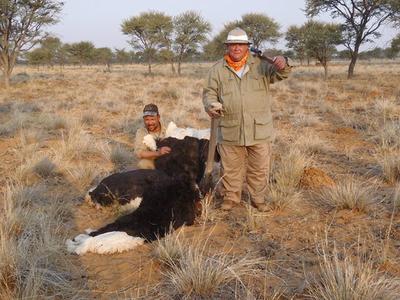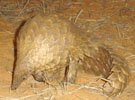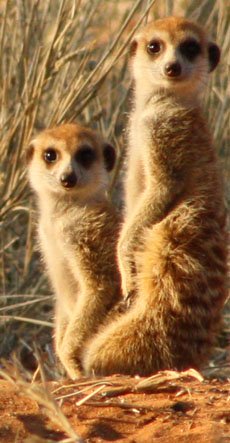For more information about our hunting safaris, don’t hesitate to reach out and contact us!
Bye Bye Birdie
by Steve Hofmann
(Illinois, USA)
I was in Central Namibia searching for caracal. One morning we came upon a flock of Guinea Fowl near a waterhole. My host had a .17 HMR rifle and he gave it to me. I took quick aim at one of the large birds and the 17 gr bullet hit it in the lower neck. The bird dropped. That bird was only the beginning.
I had brought a CZ Bobwhite .28 ga side by side to Namibia this year. I had plenty of boxes of .28 ga shells. My host had stored some boxes for me from my last trip. We encountered many doves in our search for the cat. There were three kind of doves: the Namaqua, the Ringnecked dove, and the Turtle Dove. I made a few good shots on them; they were swift and aerobatic in flight,indeed. I hit a few squarely. There was a puff of feathers; then, the birds dropped.
The next morning I was taken to a waterhole to hunt Sand Grouse. In Namibia, the flocks of Sand Grouse come to water at about 8 A.M. every morning and the flights begin to stop at about 9 A.M. You can set your watch by observing the flights of Sand Grouse in Namibia. There are two types of Sand Grouse where I hunted in Namibia. The Burchell's Sand Grouse is fairly chunky and robust, with broad wings. The Burchell's has speckled plumage. It comes over the water in large flocks. From afar; their distinctive calls can alert the hunter to their presence. The Namaqua Sand Grouse is smaller and more elusive in it's flight pattern. It's wings are not as broad as the Burchell's. They seem to cut through the air cleaner. The Namaqua has a distinctive band on it's breast. The Namaqua emits a cry that sounds like 'Choc o lot. Choc o lot' when in flight. Both Sand Grouse are very fine eating; especially with Wild Rice from America.
It was early September. The baby Sand Grouse were molted and young adults now. During their youth they were brought water in the breast feathers of their parents; sometimes as much as 60 miles from water. Very special plumage, indeed. The Sand Grouse season had started in Namibia.
I situated myself in a blind near the waterhole. At 8 A.M., just like clockwork, the Sand Grouse flocks started to appear. It was great fun trying to hit the birds with my .28 ga. They were fast and elusive and made difficult targets; especially the Namaquas. At half past 9 the bird flight ended; just like clockwork. I had harvested a few and would have a splended meal when cooked by my host in a Potjie Pot.
We said farewell to the water hole and ventured onto the veldt. We came across some Red Billed Francolin. These birds are about in between the Guinea Fowl and the Sand Grouse in size. They appear in groups. The Francolin scurried through the bush. When in flight, they are quite swift. They take off like pheasants and offer challenging targets. I succeeded in downing a few Francolin to add to the Potjie Pot. My .28 S/S was performing splendidly and was a great deal of fun to shoot. It was fast and light in weight. I could get a bead on a bird very quickly.
That evening we hunted Ostrich. I had a Ruger #1 .375 H&H Mag that I had taken plains game with. The .28 ga was out of the question for Ostrich; therefore the .375. We traveled through the veldt and encountered a huge herd of Red Hartebeest, some Blue Wildebeest, Springbok, and Blesbok. We saw a few Aardvark in search of termites. These strange appearing animals are normally nocturnal. I was priveleged to spot them on this evening hunt for Ostrich.
The sun began to set in a fiery red ball. There was stillness in the air. In the distance, perhaps 200 yards away, stood a huge Male Ostrich. The big bird was outlined by the setting sun. He offered a good and a beautiful target. I aimed my scope and rifle at the juncture of his neck and back. Right where the neck starts. I took my time. My host told me later that he feared that the Ostrich would start to run at 50 MPH; I was taking a lot of time. I aimed carefully and squeezed the trigger. The big bird dropped immediately. I had hit it right where I was aiming. My host said that it was the best shot that I had made on the whole Safari.
If anyone wants superb bird hunting; journey to Namibia!
Comments for Bye Bye Birdie
|
||
|
||
Meaning of "Uitspan"
'Uitspan' is an Afrikaans word that means place of rest.
When the Boer settlers moved inland in Southern Africa in the 1800's, they used ox carts. When they found a spot with game, water and green grass, they arranged their ox carts into a circular laager for protection against wild animals and stopped for a rest.
They referred to such an action of relaxation for man and beast, as Uitspan.
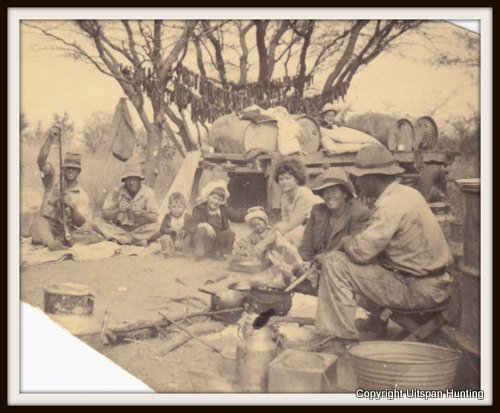
(Picture above of our ancestors.)
Did you know?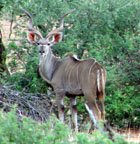 Greater Southern Kudus are famous for their ability to jump high fences. A 2 m (6.56 ft) fence is easily jumped while a 3 m (9.84 ft) high fence is jumped spontaneously. These strong jumpers are known to jump up to 3.5 m (11.48 ft) under stress. |
to read about my experience...
Did you know? Some animals have one sense more than man!The flehmen response is a particular type of curling of the upper lip in ungulates, felids and many other mammals. This action facilitates the transfer of pheromones and other scents into the vomeronasal organ, also called the Jacobson's Organ. Some animals have one sense more than man!The flehmen response is a particular type of curling of the upper lip in ungulates, felids and many other mammals. This action facilitates the transfer of pheromones and other scents into the vomeronasal organ, also called the Jacobson's Organ.This behavior allows animals to detect scents (for example from urine) of other members of their species or clues to the presence of prey. Flehming allows the animals to determine several factors, including the presence or absence of estrus, the physiological state of the animal, and how long ago the animal passed by. This particular response is recognizable in males when smelling the urine of a females in heat. |
